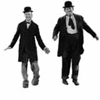I have an upcoming book titled "Tournament Casting Tackle History" in collaboration with Colby Sorrells. I think you pose some interesting questions, some of which drove us to write the book. In examine and describing all the innovations in tournament casting tackle and the event rules that drove the changes, we can answer some of your questions.
The standard Dipsi or bait casting lead sinkers were not used past 1900 for any tournaments, except in special surf events. The associations all prescribed the official weights to be used. The NAACC would have been the governing body in 1940 and the official weights used in distance would be the metal capped wood and weighted plugs, which varied each year. Distance events were primarily 5/8 and 3/8, although in 1940 due to wartime metal shortages they changed to Tenite plugs for accuracy events. The 5/8 distance remained in the metal-capped wood plugs.

There were many different distance casting events by weight and reel type. The "revolving spool" events could be unrestricted tackle or skish events requiring standard tackle. Everyone had to use the same plug, but in unrestricted events the line and reel could be anything. This drove the distance events to extremely thin lines, thin spools, and all kinds of other reel innovations. For Skish distance (and accuracy), you had to use standard unmodified reels, standard line (like the 9 lb tournament silk line) and unrestricted rods. "Reels shall be of standard manufacture and equipped with a level-winding device in working order. Arbors could be added, but no alternations of any nature whatsoever shall be permitted"
Even though the Skish reels must be standard level-wind, often the competitors looked for an edge with hollowed out gears, aluminum spools, special oils, arbors, and a variety of performance enhancing methods. It was up to the tournament weigh-master to officiate and approve any Skish equipment. A Shakespeare Professional Sportcast 1980 Mod GK could have been used in 1941. Any level-wind reel of the period might be used.
It would be interesting to try to list reels available in the 1940-1942 prewar period that might fit this bill. Most of the best Skish reels came out post war, and used the lighter weight frames and spools we would have preferred. I would think most of these reels would be capable of 200 ft casts with 5/8 weights and 9 lb line when carefully tuned.







